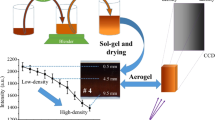Abstract
Density gradient aerogel is a kind of porous material with non-uniform density change in a specific direction. It has some unique properties and can be used in some extreme conditions. The resorcinol–formaldehyde (RF) gradient aerogels were prepared by the method based on double diffusion convection. We studied the influences of injection velocity and diffusion before gelation on the distribution of gel density gradient, and obtained an optimized injection velocity scheme. The RF density gradient aerogels were characterized by x-ray transmission imaging, scanning electron microscopy (SEM), and nitrogen adsorption–desorption isotherm. The density distribution and microstructure of the RF density gradient aerogels were obtained. The solution obtained by the optimized multi-velocities injection method presents a gradient change in the low-density part that is greater than the high-density part. This uneven change can offset the diffusion caused by the long gel time of the low-density part, and finally form a gel whose density changes uniformly with the thickness. The aerogel obtained by the optimized method ranges from 100 to 400 mg cm−3, and the density of the sample varies linearly. The results indicate that this is an efficient and direct method for preparing density gradient aerogels, and aerogels with specific density trends can be obtained by adjusting the injection velocities.

Highlights
-
Density gradient RF aerogels were prepared by the double diffusion convection method.
-
An optimized scheme combining multiple injection velocities was designed, and the reaction solution formed by it showed that the gradient change of the low-density part was more significant than the high-density part.
-
The RF aerogel with linear density variation was obtained by using the optimized scheme.









Similar content being viewed by others
References
Akimov YK (2002) Fields of application of aerogels (review). Instrum Exp Tech 46(3):287–299
Aegerter MA (2012) Aerogels handbook. Springer, New York. https://doi.org/10.1007/978-1-4419-7589-8
Attia SM, Sharshar T, Abd-Elwahed AR, Tawfik A (2013) Study of transport properties and conduction mechanism of pure and composite resorcinol formaldehyde aerogel doped with Co-ferrite. Mater Sci Eng: B 178(14):897–910. https://doi.org/10.1016/j.mseb.2013.05.005
Zhang M, Huang HJ, Wang HJ, Li ZG (2003) Development of functionally gradient materials. Mater Sci Forum 423-425:599–600. https://doi.org/10.4028/www.scientific.net/MSF.423-425.599
Das S, Das S, Nampi T, Roy K (2021) Functionally Grade Composite Material Production. Reference Module in Materials Science and Materials Engineering. https://doi.org/10.1016/b978-0-12-803581-8.11880-6
Pang X, Zhu J, Shao T, Luo X, Zhang L (2017) Facile fabrication of gradient density organic aerogel foams via density gradient centrifugation and UV curing in one-step. J Sol-Gel Sci Technol 85(1):243–250. https://doi.org/10.1007/s10971-017-4529-2
Shen Y, Du A, Li X, Huang X, Ye J, Xie Z, Wu X, Shen J, Zhou B (2016) Preparation and optimization of aerogel flyer-plates with graded density. Mater Des 110:225–232. https://doi.org/10.1016/j.matdes.2016.07.142
Tang J, Du A, Xu W, Liu G, Zhang Z, Shen J, Zhou B (2013) Fabrication and characterization of composition-gradient CuO/SiO2 composite aerogel. J Sol-Gel Sci Technol 68(1):102–109. https://doi.org/10.1007/s10971-013-3140-4
Jones SM (2006) Aerogel: space exploration applications. J Sol-Gel Sci Technol 40:351–357. https://doi.org/10.1007/s10971-006-7762-7
Brownlee DE (2003) Stardust: Comet and interstellar dust sample return mission. J Geophys Res 108(E10). https://doi.org/10.1029/2003je002087
Tsou P (1995) Silica aerogel captures cosmic dust intact. J Non-Crystalline Solids 186:415–427
Brownlee DE, Tsou P, Atkins KL, Yen CW, Vellinga JM, Price S, Clark BC(1996) Stardust: finessing expensive cometary sample returns Acta Astronautica 39:51–60. https://doi.org/10.1016/S0094-5765(96)00122-1
Koenig M, Benuzzi-Mounaix A, Philippe F, Faral B(1999) Laser driven shock wave acceleration experiments using plastic foams Appl Phys Lett 75(19):3026–3028. https://doi.org/10.1063/1.125222
Teyssier RRD, Remington B (2000) Accelerating shock waves in a laser-produced density gradient. Astrophysical J Suppl 127(2):503–508. https://doi.org/10.1086/313338
Borisenko NG, Bugrov AE, Burdonskiy IN, Fasakhov IK, Gavrilov VV, Goltsov AY, Gromov AI, Khalenkov AM, Kovalskii NG, Merkuliev YA, Putilin MV, Yankovskii GM, Zhuzhukalo EV (2008) Microheterogeneous plasma from polymer aerogel and foam at powerful laser interaction. J Phys: Conf Ser 112(2). https://doi.org/10.1088/1742-6596/112/2/022013
Jones SM (2007) A method for producing gradient density aerogel. J Sol-Gel Sci Technol 44:255–258. https://doi.org/10.1007/s10971-007-1618-7
Gui J-Y, Zhou B, Zhong Y-H, Du A, Shen J (2011) Fabrication of gradient density SiO2 aerogel. J Sol-Gel Sci Technol 58(2):470–475. https://doi.org/10.1007/s10971-011-2415-x
Oakdale JS, Smith RF, Forien J-B, Smith WL, Ali SJ, Bayu Aji LB, Willey TM, Ye J, van Buuren AW, Worthington MA, Prisbrey ST, Park H-S, Amendt PA, Baumann TF, Biener J (2017) Direct laser writing of low-density interdigitated foams for plasma drive shaping. Adv Funct Mater 27(43). https://doi.org/10.1002/adfm.201702425
Xue N, Khodaparast S, Zhu L, Nunes JK, Kim H, Stone HA (2017) Laboratory layered latte. Nat Commun 8(1):1960. https://doi.org/10.1038/s41467-017-01852-2
Shao T, Feng X, Wang W, Jin Y, Cheng Y (2012) Visualization of coupled mass transfer and reaction between gas and a droplet using a novel reactive-PLIF technique. Chem Eng J 200-202:549–558. https://doi.org/10.1016/j.cej.2012.06.113
H. Tamo HI, Mikami M, Okazaki M (1997) Porous structure of organic and carbon aerogels synthesized by sol-gel polycondensation of resorcinol with formaldehyde. Carbon 35:791–796. https://doi.org/10.1016/S0008-6223(97)00024-9
Rouquerol J, Rouquerol F, Llewellyn P, Maurin G, Sing K (2013) Adsorption by powders and porous solids. Academic Press, UK. https://doi.org/10.1016/C2010-0-66232-8
Acknowledgements
This work was supported by the Foundation of Science and Technology on plasma physics Laboratory of China Academy of Engineering physics. Thanks to Xuan Luo, Xin Tang, and Qi Yang for their constructional discussions.
Author information
Authors and Affiliations
Corresponding author
Ethics declarations
Conflict of interest
The authors declare no competing interests.
Additional information
Publisher’s note Springer Nature remains neutral with regard to jurisdictional claims in published maps and institutional affiliations.
Rights and permissions
About this article
Cite this article
Li, J., Yuan, L., Yang, X. et al. Fabrication and characterization of resorcinol–formaldehyde gradient aerogels by double-diffusive convection. J Sol-Gel Sci Technol 99, 284–294 (2021). https://doi.org/10.1007/s10971-021-05568-0
Received:
Accepted:
Published:
Issue Date:
DOI: https://doi.org/10.1007/s10971-021-05568-0




